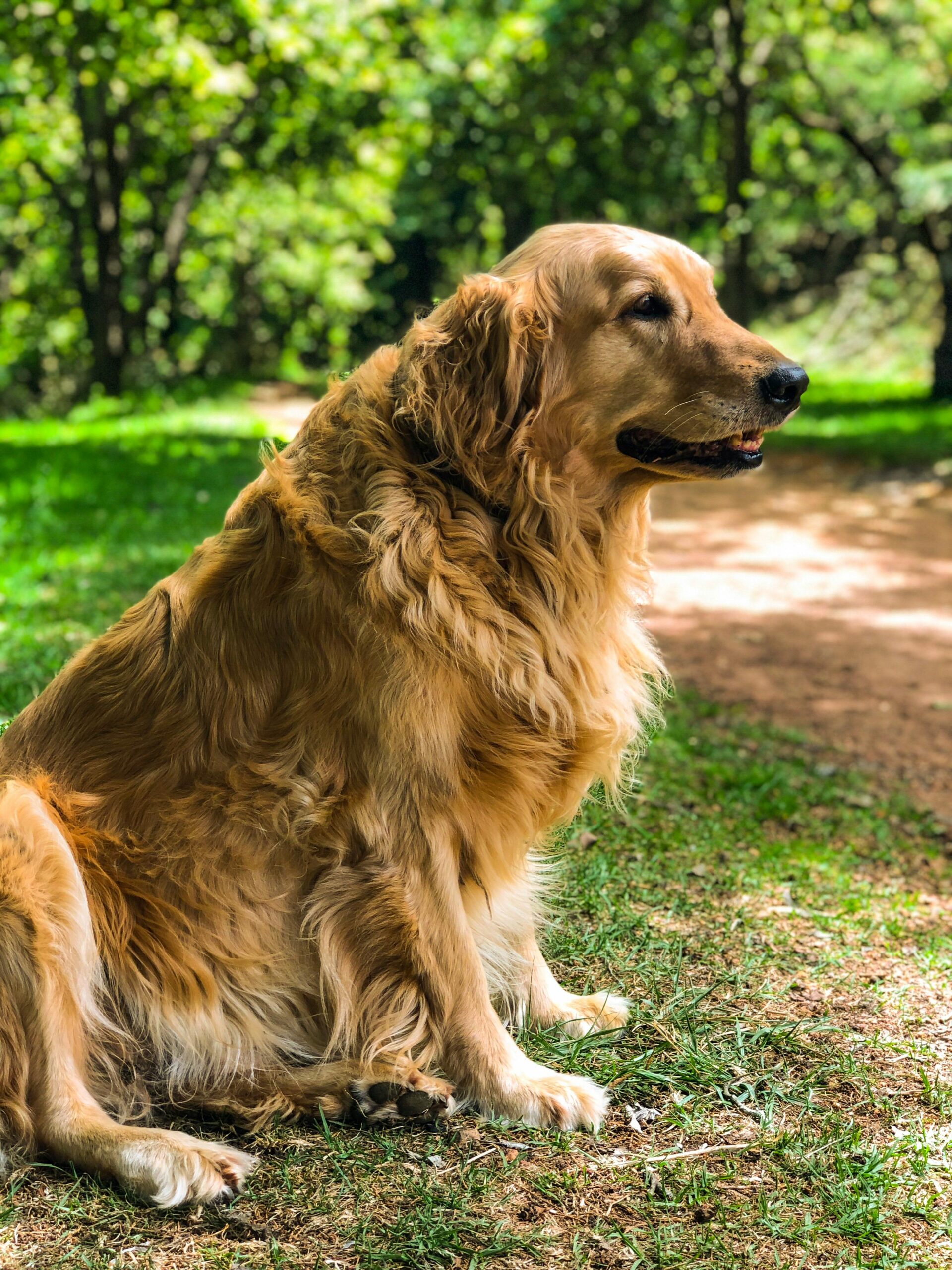Golden Retrievers are one of the most beloved dog breeds in the world, known for their friendly temperament, intelligence, and loyalty. To ensure your Golden Retriever stays healthy and happy, it’s essential to provide proper nutrition, training, and grooming. In this guide, we’ll cover everything you need to know about feeding, training, and maintaining the coat of your Golden Retriever.

Golden Retriever Diet: What to Feed and What to Avoid
A well-balanced diet is crucial for your Golden Retriever’s overall health. Since they are an active breed, they require high-quality food that provides the right balance of protein, fat, carbohydrates, and essential nutrients.
1. Best Diet for a Golden Retriever
Golden Retrievers thrive on a diet rich in:
- Protein (25-30% of their diet): Supports muscle development. Look for high-quality sources like chicken, beef, fish, or turkey.
- Healthy Fats (10-15% of their diet): Helps with skin and coat health. Include sources like fish oil, flaxseed, and chicken fat.
- Carbohydrates: Provides energy. Good sources include brown rice, sweet potatoes, and oats.
- Fruits & Vegetables: Carrots, blueberries, spinach, and pumpkin can be added for fiber, antioxidants, and essential vitamins.
- Omega-3 & Omega-6 Fatty Acids: Helps keep their coat shiny and reduces inflammation.
2. Foods to Avoid
Certain foods are toxic or harmful to Golden Retrievers:
- Chocolate
- Onions and garlic
- Grapes and raisins
- Avocado
- Artificial sweeteners like xylitol
- Cooked bones (can splinter and cause internal injuries)
- Excessively fatty foods (can lead to obesity and pancreatitis)
3. Feeding Schedule
- Puppies (8 weeks – 6 months): 3-4 small meals per day
- Adults (6 months – 7 years): 2 meals per day
- Seniors (7 years and older): 2 meals per day, but consider a diet lower in calories to prevent obesity.
Golden Retriever Training Tips: Raising a Well-Behaved Dog
Golden Retrievers are intelligent and eager to please, making them relatively easy to train. However, consistency and positive reinforcement are key.
1. Basic Obedience Training
Start with essential commands:
- Sit: Helps with impulse control.
- Stay: Prevents unnecessary running or accidents.
- Come: Important for recall, especially in open spaces.
- Leave It: Prevents them from eating harmful things.
- Heel: Keeps them from pulling on the leash.
2. House Training
- Crate training can help prevent accidents in the house.
- Take them outside frequently, especially after meals, naps, or playtime.
- Reward them with treats and praise when they relieve themselves outside.
3. Socialization
- Expose your Golden Retriever to different environments, people, and other pets at an early age.
- Arrange playdates with other dogs to encourage friendly behavior.
- Reward calm and friendly interactions with treats or praise.
4. Leash Training
Golden Retrievers are naturally enthusiastic, so leash training is crucial:
- Start indoors or in a quiet area.
- Use a no-pull harness if necessary.
- Reward them when they walk beside you without pulling.
5. Mental Stimulation
Golden Retrievers need mental challenges to prevent boredom:
- Puzzle toys, interactive feeders, and hide-and-seek games can keep them engaged.
- Obedience training and agility courses can be a great way to challenge them.
Golden Retriever Grooming Tips: Keeping Their Coat Healthy
Golden Retrievers have a thick double coat that requires regular grooming to keep them looking their best and to prevent health issues like matting and skin infections.
1. Brushing
- Brush your Golden Retriever at least 3-5 times a week to reduce shedding and prevent tangles.
- Use a slicker brush to remove loose fur and a de-shedding tool during heavy shedding seasons (spring and fall).
- Pay extra attention to the feathering on their legs, tail, and underbelly, as these areas tangle easily.
2. Bathing
- Bathe them once every 6-8 weeks or as needed.
- Use a dog-specific shampoo to maintain their coat’s natural oils.
- Dry them thoroughly to prevent skin infections.
3. Ear Cleaning
Golden Retrievers have floppy ears, which make them prone to infections.
- Clean their ears once a week using a vet-approved ear cleaner.
- Never insert cotton swabs deep into the ear canal.
4. Nail Trimming
- Trim their nails every 3-4 weeks to prevent overgrowth and discomfort.
- If you hear their nails clicking on the floor, it’s time for a trim.
5. Dental Care
- Brush their teeth at least 2-3 times a week with a dog-specific toothbrush and toothpaste.
- Provide dental chews or raw bones to reduce plaque buildup.
6. Coat Trimming
- Golden Retrievers do not need full haircuts, but occasional trimming around the ears, paws, and tail can help keep them tidy.
- If you’re unsure, a professional groomer can help shape their coat properly.
Conclusion
Taking care of a Golden Retriever involves a balance of proper diet, consistent training, and routine grooming. A well-fed, well-trained, and well-groomed Golden Retriever will not only be healthier but will also bring you years of joy and companionship.
FAQs about Golden Retriever Care
1. What is the best diet for a Golden Retriever?
A balanced diet with high-quality protein, healthy fats, and complex carbohydrates is ideal. Look for dog foods with real meat (chicken, beef, or fish) as the first ingredient.
2. How often should I feed my Golden Retriever?
Puppies need 3-4 small meals a day, while adults and seniors should have two meals per day.
3. How can I stop my Golden Retriever from pulling on the leash?
Use positive reinforcement, a no-pull harness, and stop walking when they pull. Reward them when they walk beside you without tension.
4. How often should I groom my Golden Retriever?
Brush them 3-5 times per week, bathe them every 6-8 weeks, clean their ears weekly, and trim their nails every 3-4 weeks.
5. Do Golden Retrievers shed a lot?
Yes, they are heavy shedders, especially during spring and fall. Regular brushing helps control shedding.
6. When should I start training my Golden Retriever puppy?
Start basic training as early as 8 weeks old, focusing on house training and simple commands.
7. Are Golden Retrievers good with children?
Yes! Golden Retrievers are gentle, patient, and playful, making them excellent family pets.
8. How much exercise does a Golden Retriever need daily?
At least 1-2 hours of exercise per day, including walks, playtime, and mental stimulation.
9. What are the signs of ear infections in Golden Retrievers?
Common signs include excessive scratching, head shaking, redness, and a bad odor from the ears. Regular ear cleaning helps prevent infections.
10. How can I keep my Golden Retriever mentally stimulated?
Interactive toys, obedience training, agility courses, and puzzle games help keep them engaged and prevent boredom.

